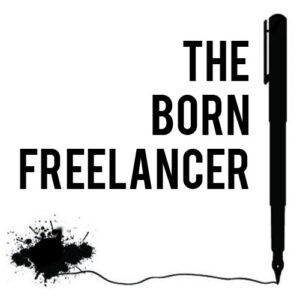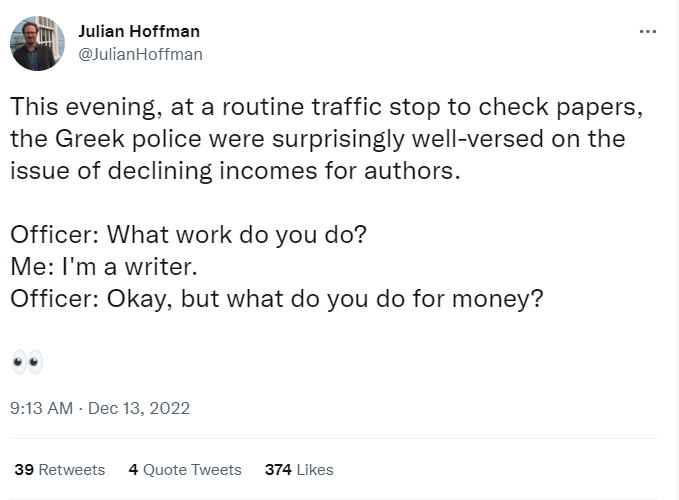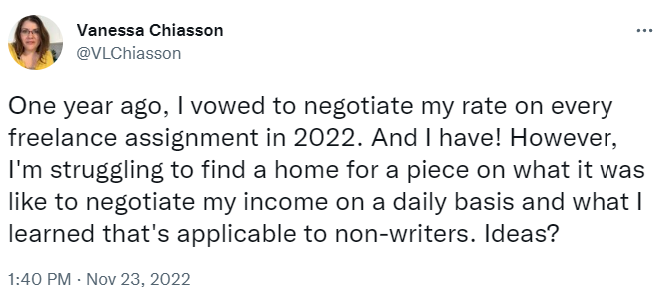Build your freelance business with these five easy social media tweaks
by Robyn Roste
In October 2010 I joined Twitter. I had heard it was a good place to get freelance work so I put up a profile, followed a few people and tweeted when the mood struck. In general this was while I watched sports or when something interesting happened.
While I was having a great time, I wasn’t getting any work and wondered what I was doing wrong. So I took a social media course for freelancers. The strategies weren’t rocket science but they were a fundamental mindset shift, which took me some time to wrap my head around. As I implemented the tactics, much to my amazement, I began getting freelance work. It changed my entire freelance business and social media is now an integral part of my marketing strategy.
Freelancers emerging from longstanding in-house corporate gigs, or who are new to the freelance world, may be blinking in the bright lights of social media wondering how on earth they’re meant to use this tool to connect with potential clients or employers. I get it. How does posting photos on Instagram result in paying clients? How does linking an article on Facebook grab potential employers’ attention and encourage them to reach out? On the surface it makes no sense.
The digital landscape is confusing and overwhelming to say the least. When I got into social media marketing there were three networks with straightforward strategies. Today, there are many more platforms and the rules seem to be ever-changing. Tactics that worked a few years ago don’t seem as effective anymore. So what is a freelancer to do?
Read the rest of this post »
Is it possible for freelance writers to beat the rap of “starving artists”?
This article is written by Vanessa Chiasson, a freelance writer based in Ottawa who specializes in travel and human interest stories.
Freelance writer Julian Hoffmann got a lot of laughs recently when he Tweeted the following:
This evening, at a routine traffic stop to check papers, the Greek police were surprisingly well-versed on the issue of declining incomes for authors.
Officer: What work do you do?
Me: I’m a writer.
Officer: Okay, but what do you do for money?
Hoffmann’s encounter was funny but worrisome. Is it possible for freelance writers to beat the rap of “starving artists”?
It’s a question I’ve been asking myself a lot in the last few months. In 2022, I made a vow to negotiate every assignment. It was a worthwhile project and 68 per cent of my work benefited from my willingness to ask: “Is there any wiggle room in the budget?” But when I added up my earnings I found that I increased my income by less than $2,000.
How could I have been so successful yet fruitless at the same time? It all comes down to the base rates upon which I was negotiating. In many cases, they were so paltry that no amount of bargaining would have netted a reasonable income. How could I determine fair value—and my value—going forward?

For financial literacy councillor Pamela George, freelance success starts with knowing your worth—but to get there, you need a bit of education. She points out that even a lucrative assignment might not be as good as it seems, adding that you’d be lucky to keep 50 per cent of what you make. You have to pay taxes on your income and that means setting aside a good chunk of money from each client. It also means accounting for expenses, from pens and pencils to conference fees. She advises people to ditch the starving artist mentality and instead to brush up on their financial literacy skills to know in very concrete terms what kind of rates it will take to support their lifestyle.
Entrepreneurship coach Lara Wellmen points out that identifying big financial goals brings additional benefits, even when it’s difficult to step outside your comfort zone. She says,
“Asking for more, no matter how reasonable it is, can feel bold and pushy—and we’ve taught not to be those things (especially women!) Stepping through the discomfort to advocate for yourself not only might mean a bit more money in your pocket, but it’s the first step in showing you that things that feel difficult can be easier than you thought, and that they’re worth the effort. It’s empowering and builds confidence, and those two things are what it’s all about when it comes to having built a business and life that feels good.”
George and Wellman’s combined wisdom is going to drive my financial planning for the coming year. I will still negotiate every freelance assignment but I’m going to start with publications that pay higher base rates. It’s daunting, to say the least. But I also know that I’m building a life of empowerment, not just a bank account. A year of negotiating has taught me that I’ve got the nerve to ask for more. Now it’s time to go get it.
The Born Freelancer on Daily Structure
This series of posts by the Born Freelancer shares personal experiences and thoughts on issues relevant to freelancers. Have something to add to the conversation? We’d love to hear from you in the comments.

The Born Freelancer on Daily Structure
Perhaps the greatest advantage of freelancing is that our time is our own. It is the definitive reason why many of us become and remain freelancers.
Recently, a veteran broadcaster told me the freedom to decide what to do with her time was the most appealing aspect of going freelance. That included making time with family and friends.
I wholeheartedly concur. However, if we fail to properly manage it, time can become our number one nemesis, denying us any hope of achieving our goals.
The trick is to recognize and prioritize goals and the activities required to achieve them. Some call it something like “time management.” I call it living productively within the freedom of the freelancing life. It takes a certain toughness of mind.
The human need for structure
Nine-to-fivers have a daily externally-imposed structure. The danger to any freelancer is that a whole day or week or more without a defined schedule or structure can effortlessly disappear. Think of the recent pandemic. Without regular structures many folk could no longer discern what day it was or even what they should be doing.
So what is needed is to identify goals, figure out requisite activities and then develop tools to facilitate a system to prioritize and organize them. It’s a way of creating your own structure.
Identifying goals, defining activities
What goals do you want to achieve with your time? What do you need to do to reach them?
For me, my freelancing life goals are best facilitated by the following activities:
Research
The goal of research is to find out about stuff. I need to know lots of stuff to write about it. Research may take place online or at the library. It might require personal interviews or visiting locations. It may help me decide what I want to write or it may be on topics already chosen. It may also include investigating creative outlets I wish to market/sell my services to.
Marketing/selling
The goal of marketing/selling is to actually make a sale. It can include short term selling such as cold calling, emailing, social media, in person interviews, etc as well as longer term marketing such as maintaining a brand presence online, attending future networking opportunities, and so on.
Creative work
Creative work’s goal is to be the thing you do in order to be the most successful at being you. It may include work you have been commissioned to do immediately as well as speculative work you hope to sell one day (like a novel). You will probably have several creative projects on the go at once.
Admin(istration)
The goal of administration is to facilitate the forward motion of your freelancing. This can include sending out invoices, paying taxes, archiving your work, and so on. It is easy to let admin pile up but this will only impede every other aspect of your freelancing life.
Personal time
The goal of allocating yourself personal time is to make sure there’s plenty of it to do everything else in your life! This should include seeing family and friends, tending to your health, relaxing, and so on. Without including it as an actual category it is easily put to one side. Its absence can cause mental and physical distress. Some days there is nothing more important than making time for lunch with an old friend.
Prioritization using visualization
The next step is to identify the priority for each activity.
One of the keys to successful freelancing is flexibility. One day you may be on deadline so “creative work” will dominate. Another day personal matters may take precedence. It is always your decision. How much time is needed for each activity will be unique to each individual, learned by self-awareness gained through experience.
So you need to create a daily flexible structure or schedule. There are, of course, numerous smartphone apps and computer programs designed to help you do just that.
I remain an advocate of old-school large-scale visualization as the definitive tool to help make my daily structure come alive.
Namely, a huge cork bulletin board upon which I tack small coloured filing cards with each day’s required activities. The board is divided vertically into work days and horizontally into work hours and my daily goals can be listed in priority. The colours indicate categories, with specifics written in. This gives me an immediate and graphically striking visualization of my day and week ahead and allows me to stop worrying about what I should be doing and just get on with it.
Don’t have a bulletin board? Use a spare wall, filing cards and sticky tack. Or how about a huge whiteboard. It can be immediately erased and rewritten to adapt to changing aspects of your day. A colleague uses the bare side of their fridge with small magnets affixed to slips of paper. This too is easy to rearrange.
I also employ a large wall calendar to look at the month ahead to see what deadlines are approaching.
Whatever the method, such an attention-focusing visualization tool allows me to instantly “see” and organize my time. I can look at the board and know at a glance what I should be doing, what I’ve been doing and what still needs to be doing. Changes are easily accommodated by moving the filing cards around. Need to make more sales? Put cold-calling on top of the list to do tomorrow. I update my week’s schedule every night as I see how my day has turned out and what remains a priority.
With this simple but proven system I have been able to successfully live my freelancing life and get the most out of my time. Something similar might prove helpful for you too.
The takeaway
Many freelancers claim that breaking away from nine-to-five drudgery was the big reason they became freelancers.
But I cannot imagine surviving without some kind of daily schedule .
So although having structure may rankle the free-spirit within you, take comfort in the fact that it will be your structure, created by you for you, based upon your own unique needs.
For the dedicated freelancer, it’s hard to imagine living any other way.
I negotiated every rate in 2022. So why didn’t I earn more money?
This essay is written by Vanessa Chiasson, a freelance writer based in Ottawa who specializes in travel and human interest stories. She challenged herself to negotiate her rate on every assignment in 2022. Here is part two of two on her results.

In 1884, a young college student named Anne tried in vain to publish a short story. She pitched magazines, solicited feedback, made some edits, and pitched some more. Her story, Averil’s Atonement, may have never seen the light of day if it were not for her best friend who submitted it to the Rollings Reliable Baking Powder Company’s story competition and won $25.
Can-lit fans know that “Anne” is none other than Lucy Maud Montgomery’s Anne Shirley. When Montgomery published Anne Of The Island, $25 was a handsome payday for a budding writer. (“It is perfectly amazing, the price they pay for such lies, that’s what,” said Anne’s neighbour, Mrs. Rachel Lynde.) Sadly, for many writers, $25 remains a familiar payday.
In weekly “call for pitches” newsletters, it’s striking how many outlets offer $25. Requests for highly personal or densely-reported stories go for $100 or less. As such, it feels like a real victory anytime I can sell a story for $300 and negotiate up to $325. But is that enough?
In 2022, I vowed to negotiate on every assignment and I was successful 68% of the time. Editors also offered alternative solutions to increase my price-per-word even if budgets were frozen. My first negotiation alone brought in an extra $50.
As such, it was something of a shock when I added up my haggling haul and it accounted for under $2,000.
While an extra $2,000 is always welcome, it didn’t exactly feel like a windfall after an entire year of bargaining. I soon realized that when the base rate is paltry, extra percentages don’t go very far. I was naive to think that the challenges of freelancing could be solved with a bit of fortitude and pluck in an industry that still offers $25 rates.
Freelance writer Kristin Luna shares my feelings about subpar rates. “When I started in journalism 20 years ago, standard rates across publications were $2/word… So it hurts my heart seeing journalists accept subpar rates, which continues this cycle of undervaluing writing as a craft, and not get paid what they’re worth.”
I thought I knew my worth but a series of $50 assignments proved otherwise. Another regular outlet topped out at $0.10 a word. I can’t help but wish I had used some of my negotiating moxie to pitch higher-paying outlets. I would have easily earned that extra $2,000—and then some.
It’s something writer Sucheta Rawal encourages, saying, “For 2022, I made a decision to turn down work that did not meet my minimum rate. This meant dropping a couple of publications I used to write for because they won’t increase. As a result, I not only got more work this year but almost doubled my income too.”
Montgomery herself was no stranger to the strains of freelancing. She regularly submitted stories, poems and essays when she was a student. In a 1939 piece for the Dalhousie Gazette, written when she was one of the world’s most celebrated authors, Montgomery urged would-be writers to “KEEP ON TRYING.” And that is precisely what I’m hoping to bring to my 2023 work, a mix of pragmatism and tenacity, with an occasional dash of Anne-like whimsy.
For more on negotiating rates, check out the Canadian Freelance Guild’s two-part series:
The Born Freelancer Gets Hacked!
This series of posts by the Born Freelancer shares personal experiences and thoughts on issues relevant to freelancers. Have something to add to the conversation? We’d love to hear from you in the comments.

The Born Freelancer Gets Hacked!
My digital nightmare began with a click.
When the email arrived, purportedly from my email provider, my mind was elsewhere.
A text had arrived at the same moment, severely dividing my attention.
The email asked if I was missing several replies I was expecting. It claimed a certain number of them had been blocked. For more details, I had to click the link.
Well, as it happened, I had been expecting several clients to reply to recent inquiries and had heard nothing. It made sense, to my distracted brain, that their replies were in digital limbo.
My cursor hovered over the “click” button.
A short time out
As a veteran freelancer, I knew the dangers lurking online. Bad actors try to trick us into providing details (called “phishing”) to rob us of our identities and drain our credit cards. Others, more technologically oriented, try to trick us into downloading malicious “malware” with which they can steal our passwords or take control and “lock down” our computers, holding them for ransom.
For all the anti-virus software, our computers’ biggest vulnerability remains the human factor—that is, any appeal to our needs and weaknesses. Simple and basic social engineering may emotionally trigger us into doing whatever it is they want us to do.
Consider the email I was about to click.
It claimed certain replies were being blocked. That appealed to my ego—of course my clients had replied, they would never simply ignore me. It also appealed to my deepest suspicions—of course it’s the technology at fault. And it correctly presumed my distracted mind would not notice the telltale giveaways of its illegitimacy until it was…too late.

Back to the action—Click!
Right away I knew it was a mistake.
Multiple images appeared in a rapidly flashing succession of unknown websites until, after the hard drive produced a noise like shifting gears in an old Model T Ford, it froze.
In what seemed like hours, but was probably no more than seconds, I disconnected from the Internet.
But it was too late.
I had allowed myself to be hacked.
Stupid, stupid, stupid. How could I have been so stupid?
This question ran through my mind until the advice of a tech-savvy colleague brought my old computer back to life, well, a kind of life. Based upon what had happened the odds were it could now harbour insidious malware. Or some portion thereof.
I can look at its files but it can never be trusted again to roam the Internet (where it could fulfil its malicious destiny) unless I pay more than it is worth today and take it to a computer repair service.
Freelancing means living within a budget. I decided the money I would have spent on repairs (had I not backed up my files) would be better spent on a newer used laptop.
With no immediate access to the Internet, my local public library came to the rescue. Using their publicly accessible computers I was able to keep in touch with the world. Thank you public libraries everywhere!
Lessons learned
- Back up your files. Many computers do this automatically to “the cloud” but I prefer a daily manual backup to an external drive. Accessing “the cloud” may not always be possible
- Never click links in unsolicited emails. Seriously. I knew this and still I clicked. They attempt to evoke a response from you exploiting your vulnerabilities. Is my account frozen? Has there been a mistake I need to put right? Or in my case, had I been missing emails? Sooner or later a socially engineered question may arrive that will click your buttons too
- Inspect emails closely. When, afterwards, I looked at the bogus email, I realized it didn’t use quite the right graphic logo. Some of the grammar was wrong too, as if written in a hurry
- If asked for personal information, DON’T GIVE IT. It may seem legitimate but probably isn’t. Do not call numbers on it to determine its authenticity. Those are probably fake too. Call the number you already have or check that company’s website
- If you suspect you’ve downloaded anything malicious, disconnect. Don’t go online again until it has been “cleaned” by a trusted computer repair service. Using another computer, change all email and log-in passwords and all saved passwords. If a credit card number was stored, cancel it immediately
- If you become the victim of ransom-ware, don’t pay. Consider your computer a write-off. (I’m assuming your files are safely backed up.) Contact the police
The takeaway
What was the end-game of my purported hackers? Planting a key stroke logger to steal my passwords or to shut down my computer until I paid a ransom?
I’ll never know. I had pulled the plug before the malicious activity was able to fully manifest. But I know it wasn’t going to be anything good.
As freelancers we have no corporate IT department constantly overseeing our online safety to turn to in our hour of digital despair. We have to safeguard our time online to the best of our abilities.
So please allow my holiday gift to you to be this advice: Never take your online safety for granted. When you least expect it, you might be manipulated by the most simple and basic social engineering.
Don’t say it couldn’t happen.
I know because it happened to me.
Have you ever suffered any online attacks or security lapses? What did you do about it? Please share your experiences using the “Comments” feature below. And yes, it is SAFE to use!
In 2022 I negotiated my rate on every freelance assignment. Here’s what happened
This essay is written by Vanessa Chiasson, a freelance writer based in Ottawa who specializes in travel and human interest stories. She challenged herself to negotiate her rate on every assignment in 2022. Here is part one of two on her results.

Many people go their entire life without ever asking for a raise. In 2022, I did it every day.
Or, very nearly so. As a freelance writer, I diligently keep an eye on my bottom line. I know much of my success doesn’t come from my brilliant ideas but from my ability to manage my business as, well, a business. In the face of an increasingly uncertain economy, I knew if I wanted to thrive, I’d have to ask some hard questions, starting with one that most people dread: Is that the best you can do? It’s a query I raised with editors for a year now.
I was motivated to tackle my rates in part by the hosts of The Writer’s Co-op Podcast, Wudan Yan and Jenni Gritters. Yan and Gritters steadily encourage writers to value their work and their personal time, to raise their rates and negotiate assignment fees instead of simply taking on additional work. Their insights felt both audacious and bewitchingly simple. Could I really do that? Just…ask for more money?
As it turns out, I could negotiate for more money, and I’m not alone in doing so.
Freelancer Pamela MacNaughton said, “I have always been a people pleaser, so negotiating rates has been a challenge. The pandemic changed that, in the sense that I’m no longer willing to sacrifice myself or my worth.” Meanwhile, writer Jill Schildhouse reported that negotiating, “Adds up if you keep doing it…. Just ask…. The worst thing they can say is no.”
I vowed to ask my assigning editors for more than the offered fee, no matter how big or small the piece. However, the idea of negotiating anything, let alone everything, is a misery to me. I’m a big ol’ scaredy cat. I knew I needed a way to stay accountable to myself when my courage waned and decided I’d track my endeavour on a spreadsheet.
My efforts were soon rewarded. My very first negotiation earned me an extra $50. Since then, a whopping 68% of my assignments have benefited from my willingness to ask for more. In doing so, my confidence has soared and not just because of the positive responses.
Editors who said no were often my biggest cheerleaders, encouraging me to keep asking and regretting that they weren’t in a position to increase rates. Tom Firth, Managing Editor of Culinaire, was one such champion. I asked him what motivated him to give such a supportive “no” and he said, “I completely understand getting asked if there is more budget for something…it’s not something that I ‘like’ being asked generally, since I rarely have a favourable answer, but it does keep us thinking about our rates. I never mind being asked, and firmly believe that if I am being asked politely or openly about the budget for an article, then I certainly can reply in much the same fashion.”
Overall, I can’t say that I ever got especially comfortable asking for more money but it no longer feels intimidating. It’s simply another good freelance business practice, right up there with tracking receipts. I’m tremendously proud of my efforts and my success rate. However, when I did my final financial calculations, my income revealed some hard truths I wasn’t expecting. Stay tuned for what I learned about money and publishing in my next instalment.
Journalism or Content Writing
by Steven Threndyle
Tag along with me as I scroll through various job feeds, searching for the next lucrative writing opportunity. If you’re a recent journalism graduate or a top-notch freelancer yearning for steadier work, JeffGaulin.com is still a go-to resource for sussing out the job market. And while there are more than the 50-plus jobs listed on Gaulin’s great site as of Canada Day, one’s career horizons can be expanded greatly by considering “content writing” jobs.

Journalism or content writing
Broadcast journalists/anchors and newspaper reporters follow a relatively straightforward career path—usually from journalism school through to small-town starter jobs and then on to fame in major cities (if not the national level), the content creator—like the freelance writer—flies by the seat of their pants.
But what, really, do we mean by “content”?
It was Bill Gates who foretold the future when he wrote his famous Content Is King essay on the Microsoft website way back in 1996. For Gates, “content” was all-encompassing, describing every scrap of information that “consumers” (as opposed to mere readers) might digest at any given time.
Gates’ remarkably prescient essay (remember: this is 1996, pre social media and even pre-broadband Internet access) noted that: “For the Internet to thrive, content providers must be paid for their work. The long-term prospects are good, but I expect a lot of disappointment in the short-term as content companies struggle to make money through advertising or subscriptions. It isn’t working yet, and it may not for some time.”
While there over a dozen journalism schools in Canada, content writing is usually just one component in a digital marketing program often taught by privately owned (and expensive) institutions such as BrainStation. You can familiarize yourself by taking LinkedIn courses and watching YouTube videos, which are likely as valuable to list on your resume as “life experience.”
In short, a journalism grad will spend in the neighbourhood of $50,000 to obtain a degree (then fight tooth and nail to get a foot in the door), content writers can watch a few videos, throw up a five-minute website on Weebly or Wix and be off to the races.
Most business websites exist for a single reason, and that’s to solve a problem that’s prompted by a Google search. A high percentage of content writing jobs require at least a cursory knowledge of Search Engine Optimization (SEO), Search Engine Page Ranking (SERP) and Search Engine Marketing (SEM). Again, there are plenty of online webinars showing writers how to use various digital marketing tools, but at some point, an employer will have to take a chance on you.
In the same way that journalists should understand how the media business works, content writers must know who’s paying their salary. CBC/Radio Canada, Rogers, Bellmedia and Postmedia are household names; ShoutVox, Black and White Zebra, Trulioo and Thinkific (which just slashed its workforce) are not. Unless you’re a tech writer, chances are you won’t know much about a company like System1, “a leading online customer acquisition marketing company that operates the largest Responsive Acquisition Marketing Platform (RAMP) allowing leading digital publishers and networks a single platform to monetize customers in an increasingly complex ecosystem.”
Content writing requires curiosity, creativity, attention to detail and working against hard deadlines, just like a fast-paced newsroom.
The problem is, you’ll probably be doing it in the corner of your basement dedicated to the “home office.” Depending upon how you felt about “WFH” during the pandemic, chances are you’ll go an entire career—especially since many content writing jobs are contracts—without ever meeting your co-workers or boss face-to-face.
Journalism grads know that they often have have to slug it out in the trenches at small-town newspapers and radio stations across Canada for atrociously low salaries. Content writing provides perhaps more of an illusion of control—since much of the work is contract-based, writers can quickly move on from a bad gig without worrying too much about burning a bridge.
Plum job postings offer staggering six-figure salaries and if you take your job search to Twitter, you’ll feel like a loser if you’re not pulling down $10K per month in billings. Indeed (bad pun, I know), the vast majority of content writing jobs don’t provide compensation figures at all. Many entry-level writing jobs pay abysmally—under five cents a word—with no guarantee of work. There’s a certain segment of the content writing biz that looks and sounds a lot like the gig economy; something you might bang away at in the wee hours for 50 bucks.
Taking time off when you’re a freelancer
by Robyn Roste

As a freelancer, taking time off from work can be a scary thought.
What if an inquiry comes in while you’re away and you miss out on a great opportunity?
What if there’s a client emergency and you let them down?
And what if you go on vacation and then have no work to come back to because you stopped prospecting?
These fears are all possible scenarios so they’re important to think through. However, rest is necessary to fuel creativity and avoid burnout. So how does a freelancer take breaks without losing money, clients or opportunities? Here are a few ideas.
Calculate vacation time into your rate.
When you’re a traditional employee you receive either vacation time or vacation pay so you can take time off to rest and recuperate without the burden of financial loss. As a self-employed freelancer, you can plan for this as well.
Calculating for vacation time could be simple or complex but it all begins with the end in mind. Set your annual goal wage, add in your business and life expenses (including taxes) and add an amount for vacation.
Read the rest of this post »
The Born Freelancer Talks with Mary Ito About Podcasting
This series of posts by the Born Freelancer shares personal experiences and thoughts on issues relevant to freelancers. Have something to add to the conversation? We’d love to hear from you in the comments.

Mary Ito, the popular Toronto-based veteran broadcast journalist, has had a successful career in both radio and television at a number of stations, most recently as a regular host on CBC Radio. In fact, if you owned a TV or radio anywhere in Southern Ontario (and sometimes even farther) over the last few decades it would have been hard to miss her cheerful voice and wicked sense of humour. Ito’s strength, however, has always been her unique ability to effortlessly shift from medium to medium, and from topic to topic—from the lighthearted to the much more serious and profound. Her natural sense of curiosity, combined with well-honed journo skills, have served her well throughout a career both extremely varied and highly demanding.
Her latest bold venture has been to return to freelancing in order to take on a number of projects including an exciting new challenge: podcasting. Never one to do anything by half-measures, it will surprise no one familiar with her work to learn Ito has launched not one but two original podcasts this year.
The Born Freelancer talks with Mary Ito about podcasting
THE BORN FREELANCER: Mary Ito, welcome! You’re a freelancer again after being under contract for so long at so many places. How does it feel?
MARY ITO: Very freeing! I always wished there were more hours in a day to do all the things I wanted to do when I was working full time. But when you’re doing a news or magazine-style show as I’ve done in the past, there’s so much to stay on top of. A lot of reading, research and prep work that you have to do on a daily basis. And making time for family and friends too—that’s always been a priority. There wasn’t a lot of time for other stuff like continuing education, special projects and of course having more fun!
TBF: Which leads us to your two new podcasts. Let’s start with the CRAM Podcast.
MARY ITO: CRAM is an acronym for “Communicating Research And More.” Our intent is to let the public know about innovative, exciting research and big ideas that are being generated in our universities and other institutions—knowledge that can impact lives. I interview researchers and big thinkers across Canada. Topics have ranged from “Love in the Time of Covid,” “Why We Make the Decisions We do,” “Rethinking Pain,” and “Lessons on War and Sex.”
TBF: And your second podcast, Passage to Wonderland?
MARY ITO: PTW is a literary podcast in which I read excerpts from books old and new. We’ve showcased passages from the Giller Prize-winning novel “Fifteen Dogs,” the bestseller “The Woman Before Wallis,” and the new book “Step,” a collection of short stories by award-winning writer Deborah Ellis. All the excerpts have some kind of insight, discovery or conclusion to help provide someone with a sense of completion at the end of a busy day.

TBF: I recognize the name CRAM. That was the research festival you organized in Toronto back in 2019. So let’s focus on it and how the podcast evolved from it.
MARY ITO: I created CRAM because I realized that most research done in universities never reaches the public but has the potential to impact lives in all kinds of ways. So I partnered with all four of Toronto’s universities: The University of Toronto, York University, OCAD University and Toronto Metropolitan University (then Ryerson) to share their most innovative and exciting research with the public. We held over 30 free events on one night, which included interactive talks, art and video installations, demos, dance and music performances, etc. It was fantastic! Then the pandemic happened and we decided to launch the CRAM podcast at the end of January as we felt it was important to keep sharing new research and ideas with the public.
TBF: You make it sound so obvious and easy! But I bet it wasn’t.
MARY ITO: I knew nothing about podcasting when I started. I just thought it was important to keep CRAM going in some form. I’d also left regular employment at CBC to devote more time to projects I wanted to pursue like CRAM and Passage to Wonderland. I started doing some research, spoke to people who were doing podcasts and/or producing them, and thought, it’s now or never. The hardest thing for me was actually committing myself to doing it. And the hardest thing now is not the actual content or production of the podcast but the marketing of it and spreading the word.
TBF: Which is the number one challenge for many freelancers when launching their own brand. So how did you get it off the ground?
MARY ITO: It actually came together in an accidental way. I was mulling over the podcasting idea and hadn’t really taken any definite steps at that point. And then I happened to be talking with a friend of mine, Sarah Michaelis, a former television producer I’d worked with, and mentioned my podcast idea to her. She had left media but missed journalism and offered to work with me as my producer (knowing that I had zero dollars to pay her at the time!). She’d had her own production company for awhile producing videos but never a podcast. But I didn’t doubt that she could do it because she’s very talented, smart and adaptable. It was a gift to be able to work with her again!
TBF: What is her role as your producer?
MARY ITO: Sarah advised me on setting up a home studio in my basement and what equipment I’d need. She does all the recordings of interviews, editing and packaging of podcasts. She vets my scripts and we discuss potential guests and topics along with my wonderful researcher Natasha Chawdhry. I’m lucky to have such a great team!
TBF: So assembling a talented team seems like more than half your battle won. But what about your role as host? What new challenges did podcasting throw at you?
MARY ITO: This has been real “on the job” training for me. I’ve been so used to working in a traditional radio format hosting shows with a lot of moving parts and doing short interviews. I’ve had to get used to long format interviews of 30-45 minutes (which I really love) and bringing more of myself into the conversation, which I’m not used to doing.
TBF: Many freelancers are still trying to figure out how to monetize their podcasting efforts. Is that an issue for you too?
MARY ITO: The purpose of the CRAM podcast is not to make money—it’s to share innovative research and ideas that impact people’s lives. But it does take money to run it and I couldn’t pay anyone at the start. It was truly a passion project for all of us. But I was fortunate to received funds from two anonymous donors and the Temerty Foundation. Now I’m able to cover expenses and pay Sarah and Natasha. I’d like to keep it as a volunteer project for me—a way to give back to the public and the amazing researchers (who really are unsung heroes) in Canada.
TBF: “Podcasting is the future of radio.” I’ve heard that often said lately. What are your thoughts?
MARY ITO: I’m not a radio or media guru so don’t know the answer to that. I’m biased since I grew up with traditional radio and worked most of my life in it. I think there’s something magical about a bunch of people all listening to the same thing at the same time. The same magic you get when you go to the theatre and you all watch a movie together. But I wonder if listening to radio is becoming more circumstantial rather than intentional—especially given the pandemic and the shift in the way we work. Podcasts fit into the way we live our lives now. On demand, whenever, wherever. I think people, especially younger generations, want those options and podcasts that offer a broad range of content that mainstream radio can’t.
TBF: Finally, Mary Ito, any advice to other freelancers who want to create their own podcast?
MARY ITO: Actually does anyone have any advice to give ME? I’m still so new at this I don’t really feel qualified to give advice. But from the POV of a newbie podcaster, I would say try and create a podcast that has something different to offer from what’s out there—and there’s a crazy amount that’s out there! Just try and stick with it and be consistent with your content. That’s the advice I was given.
Our thanks to Mary Ito for sharing her insights and experiences behind the creation of her two new podcasts. You can find them online here:
Webinar: The Anti-Hustle Method for Freelancing Freedom
As a freelancer, being a “one-person business” can feel stressful and exhausting—but it doesn’t need to be! If you’ve ever struggled with managing your time effectively and staying on top of your never-ending task list, this workshop will help you become the productive boss of your own life and business.
By the end of the workshop, you will:
- Learn how to stop the cycle of toxic productivity and the trap of unnecessary “busy” work
- Identify the productivity mistakes you’re currently making—and how to resolve them with confidence
- Create a productivity action plan that promotes work-life balance, reduces overwhelm, and frees up five to 10 hours per week
This webinar is part of the Canadian Freelance Guild’s Business of Freelancing series.
Our Presenter
 Sagan Morrow
Sagan Morrow
Sagan Morrow is an anti-hustle productivity strategist and internationally board-certified success coach.
She helps solopreneurs and multi-passionate creatives save 10+ hours every single week, maximize productivity based on their personality, and take strategic action to finally achieve their goals—without burning out or succumbing to overwhelm. Learn more about Sagan at saganmorrow.com.
The Anti-Hustle Method for Freelancing Freedom
- Online: Thursday, June 9th, 2022
- 7pm to 8pm Eastern Time
- $5 for members
- $15 for non-members
You can register for this webinar right here.
Learn more about the cost and benefits of membership in the CFG on this webpage.
The link to the Zoom webinar will be sent to you via email about half an hour before the start time.
Please check your spam or junk folders if you can’t find the email, and contact organizer@canadianfreelanceguild.ca if you haven’t received the link 10 minutes before the scheduled start time. This webinar will be recorded and posted to the CFG Video-On-Demand site. Once posted, all paid registrants will receive a link and instructions on how to view.






